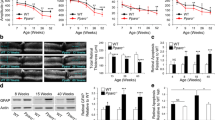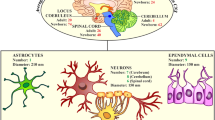Abstract
The retinal pathology in peroxisomal disorders suggests that peroxisomes are important to maintain retinal homeostasis and function. These ubiquitous cell organelles are mainly involved in lipid metabolism, which comprises α- and β-oxidation and ether lipid synthesis. Although peroxisomes were extensively studied in liver, their role in the retina still remains to be elucidated. As a first step in gaining more insight into the role of peroxisomes in retinal physiology, we performed immunohistochemical stainings, immunoblotting and enzyme activity measurements to reveal the distribution of peroxisomes and peroxisomal lipid metabolizing enzymes in the murine retina. Whereas peroxisomes were detected in every retinal layer, we found a clear differential distribution of the peroxisomal lipid metabolizing enzymes in the neural retina compared to the retinal pigment epithelium. In particular, the ABC transporters that transfer lipid substrates into the organelle as well as several enzymes of the β-oxidation pathway were enriched either in the neural retina or in the retinal pigment epithelium. In conclusion, our results strongly indicate that peroxisome function varies between different regions in the murine retina.







Similar content being viewed by others
References
Islinger M, Cardoso MJ, Schrader M (2010) Be different–the diversity of peroxisomes in the animal kingdom. Biochim Biophys Acta 1803:881–897. https://doi.org/10.1016/j.bbamcr.2010.03.013
Van Veldhoven PP (2010) Biochemistry and genetics of inherited disorders of peroxisomal fatty acid metabolism. J Lipid Res 51:2863–2895. https://doi.org/10.1194/jlr.R005959
Wanders RJ, Waterham HR (2006) Biochemistry of mammalian peroxisomes revisited. Annu Rev Biochem 75:295–332. https://doi.org/10.1146/annurev.biochem.74.082803.133329
Hoon M, Okawa H, Della Santina L, Wong RO (2014) Functional architecture of the retina: development and disease. Prog Retin Eye Res 42:44–84. https://doi.org/10.1016/j.preteyeres.2014.06.003
Strauss O (2005) The retinal pigment epithelium in visual function. Physiol Rev 85:845–881. https://doi.org/10.1152/physrev.00021.2004
Robison WG Jr, Kuwabara T (1975) Microperoxisomes in retinal pigment epithelium. Invest Ophthalmol 14:866–872
Leuenberger PM, Novikoff AB (1975) Studies on microperoxisomes. VII. Pigment epithelial cells and other cell types in the retina of rodents. J Cell Biol 65:324–334
Beard ME, Davies T, Holloway M, Holtzman E (1988) Peroxisomes in pigment epithelium and Muller cells of amphibian retina possess D-amino acid oxidase as well as catalase. Exp Eye Res 47:795–806
Deguchi J, Yamamoto A, Fujiki Y, Uyama M, Tsukahara I, Tashiro Y (1992) Localization of nonspecific lipid transfer protein (nsLTP = sterol carrier protein 2) and acyl-CoA oxidase in peroxisomes of pigment epithelial cells of rat retina. J Histochem Cytochem 40:403–410. https://doi.org/10.1177/40.3.1552178
Hazlett LD, Hazlett JC, Ireland M, Bradley RH (1978) Microperoxisomes in retinal epithelium and tapetum lucidum of the American opossum. Exp Eye Res 27:343–348
Atalla L, Fernandez MA, Rao NA (1987) Immunohistochemical localization of catalase in ocular tissue. Curr Eye Res 6:1181–1187
St Jules R, Kennard J, Setlik W, Holtzman E (1992) Frog cones as well as Muller cells have peroxisomes. Exp Eye Res 54:1–8
Schad A, Fahimi HD, Volkl A, Baumgart E (2003) Expression of catalase mRNA and protein in adult rat brain: detection by nonradioactive in situ hybridization with signal amplification by catalyzed reporter deposition (ISH-CARD) and immunohistochemistry (IHC)/immunofluorescence (IF). J Histochem Cytochem 51:751–760. https://doi.org/10.1177/002215540305100606
Lenzen S, Drinkgern J, Tiedge M (1996) Low antioxidant enzyme gene expression in pancreatic islets compared with various other mouse tissues. Free Radic Biol Med 20:463–466
Grant P, Ahlemeyer B, Karnati S, Berg T, Stelzig I, Nenicu A, Kuchelmeister K, Crane DI, Baumgart-Vogt E (2013) The biogenesis protein PEX14 is an optimal marker for the identification and localization of peroxisomes in different cell types, tissues, and species in morphological studies. Histochem Cell Biol 140:423–442. https://doi.org/10.1007/s00418-013-1133-6
Zaki MS, Heller R, Thoenes M, Nurnberg G, Stern-Schneider G, Nurnberg P, Karnati S, Swan D, Fateen E, Nagel-Wolfrum K, Mostafa MI, Thiele H, Wolfrum U, Baumgart-Vogt E, Bolz HJ (2016) PEX6 is expressed in photoreceptor cilia and mutated in deafblindness with enamel dysplasia and microcephaly. Hum Mutat 37:170–174. https://doi.org/10.1002/humu.22934
Smith CE, Poulter JA, Levin AV, Capasso JE, Price S, Ben-Yosef T, Sharony R, Newman WG, Shore RC, Brookes SJ, Mighell AJ, Inglehearn CF (2016) Spectrum of PEX1 and PEX6 variants in Heimler syndrome. Eur J Hum Genet 24:1565–1571. https://doi.org/10.1038/ejhg.2016.62
Braverman NE, D’Agostino MD, Maclean GE (2013) Peroxisome biogenesis disorders: biological, clinical and pathophysiological perspectives. Dev Disabil Res Rev 17:187–196. https://doi.org/10.1002/ddrr.1113
Ruether K, Baldwin E, Casteels M, Feher MD, Horn M, Kuranoff S, Leroy BP, Wanders RJ, Wierzbicki AS (2010) Adult Refsum disease: a form of tapetoretinal dystrophy accessible to therapy. Surv Ophthalmol 55:531–538. https://doi.org/10.1016/j.survophthal.2010.03.007
Grainger BT, Papchenko TL, Danesh-Meyer HV (2010) Optic nerve atrophy in adrenoleukodystrophy detectable by optic coherence tomography. J Clin Neurosci 17:122–124. https://doi.org/10.1016/j.jocn.2009.08.019
Abe Y, Honsho M, Nakanishi H, Taguchi R, Fujiki Y (2014) Very-long-chain polyunsaturated fatty acids accumulate in phosphatidylcholine of fibroblasts from patients with Zellweger syndrome and acyl-CoA oxidase1 deficiency. Biochim Biophys Acta 1841:610–619. https://doi.org/10.1016/j.bbalip.2014.01.001
Ferdinandusse S, Denis S, Mooijer PA, Zhang Z, Reddy JK, Spector AA, Wanders RJ (2001) Identification of the peroxisomal beta-oxidation enzymes involved in the biosynthesis of docosahexaenoic acid. J Lipid Res 42:1987–1995
Martinez M (2001) Restoring the DHA levels in the brains of Zellweger patients. J Mol Neurosci 16:309 – 16; discussion 317 – 21. https://doi.org/10.1385/jmn:16:2-3:309
Troffer-Charlier N, Doerflinger N, Metzger E, Fouquet F, Mandel JL, Aubourg P (1998) Mirror expression of adrenoleukodystrophy and adrenoleukodystrophy related genes in mouse tissues and human cell lines. Eur J Cell Biol 75:254–264. https://doi.org/10.1016/s0171-9335(98)80121-0
Burgoyne T, Lane A, Laughlin WE, Cheetham ME, Futter CE (2018) Correlative light and immuno-electron microscopy of retinal tissue cryostat sections. PLoS One 13:e0191048. https://doi.org/10.1371/journal.pone.0191048
Miceli MV, Liles MR, Newsome DA (1994) Evaluation of oxidative processes in human pigment epithelial cells associated with retinal outer segment phagocytosis. Exp Cell Res 214:242–249. https://doi.org/10.1006/excr.1994.1254
Ng MC, Shichi H (1989) Peroxisomal palmityl CoA oxidase activity in ocular tissues and cultured ciliary epithelial cells. J Ocul Pharmacol 5:65–70
Kobayashi K, Kobayashi H, Ueda M, Honda Y (1997) Expression of 17 beta-hydroxysteroid dehydrogenase type IV in chick retinal pigment epithelium. Exp Eye Res 64:719–726. https://doi.org/10.1006/exer.1996.0262
Acar N, Gregoire S, Andre A, Juaneda P, Joffre C, Bron AM, Creuzot-Garcher CP, Bretillon L (2007) Plasmalogens in the retina: in situ hybridization of dihydroxyacetone phosphate acyltransferase (DHAP-AT)--the first enzyme involved in their biosynthesis–and comparative study of retinal and retinal pigment epithelial lipid composition. Exp Eye Res 84:143–151. https://doi.org/10.1016/j.exer.2006.09.009
Baes M, Huyghe S, Carmeliet P, Declercq PE, Collen D, Mannaerts GP, Van Veldhoven PP (2000) Inactivation of the peroxisomal multifunctional protein-2 in mice impedes the degradation of not only 2-methyl-branched fatty acids and bile acid intermediates but also of very long chain fatty acids. J Biol Chem 275:16329–16336. https://doi.org/10.1074/jbc.M001994200
Kawaguchi K, Morita M (2016) ABC transporter subfamily D: distinct differences in behavior between ABCD1-3 and ABCD4 in subcellular localization, function, and human disease. Biomed Res Int 2016:6786245. https://doi.org/10.1155/2016/6786245
Yagita Y, Shinohara K, Abe Y, Nakagawa K, Al-Owain M, Alkuraya FS, Fujiki Y (2017) Deficiency of a retinal dystrophy protein, acyl-CoA binding domain-containing 5 (ACBD5), impairs peroxisomal beta-oxidation of very-long-chain fatty acids. J Biol Chem 292:691–705. https://doi.org/10.1074/jbc.M116.760090
Hua R, Cheng D, Coyaud E, Freeman S, Di Pietro E, Wang Y, Vissa A, Yip CM, Fairn GD, Braverman N, Brumell JH, Trimble WS, Raught B, Kim PK (2017) VAPs and ACBD5 tether peroxisomes to the ER for peroxisome maintenance and lipid homeostasis. J Cell Biol 216:367–377. https://doi.org/10.1083/jcb.201608128
Nazarko TY, Ozeki K, Till A, Ramakrishnan G, Lotfi P, Yan M, Subramani S (2014) Peroxisomal Atg37 binds Atg30 or palmitoyl-CoA to regulate phagophore formation during pexophagy. J Cell Biol 204:541–557. https://doi.org/10.1083/jcb.201307050
Ferdinandusse S, Falkenberg KD, Koster J, Mooyer PA, Jones R, van Roermund CWT, Pizzino A, Schrader M, Wanders RJA, Vanderver A, Waterham HR (2017) ACBD5 deficiency causes a defect in peroxisomal very long-chain fatty acid metabolism. J Med Genet 54:330–337. https://doi.org/10.1136/jmedgenet-2016-104132
Dirkx R, Meyhi E, Asselberghs S, Reddy J, Baes M, Van Veldhoven PP (2007) Beta-oxidation in hepatocyte cultures from mice with peroxisomal gene knockouts. Biochem Biophys Res Commun 357:718–723. https://doi.org/10.1016/j.bbrc.2007.03.198
Abe S, Nagai T, Masukawa M, Okumoto K, Homma Y, Fujiki Y, Mizuno K (2017) Localization of protein kinase NDR2 to peroxisomes and its role in ciliogenesis. J Biol Chem 292:4089–4098. https://doi.org/10.1074/jbc.M117.775916
Handa JT (2012) How does the macula protect itself from oxidative stress? Mol Aspects Med 33:418–435. https://doi.org/10.1016/j.mam.2012.03.006
Dieuaide-Noubhani M, Novikov D, Vandekerckhove J, Veldhoven PP, Mannaerts GP (1997) Identification and characterization of the 2-enoyl-CoA hydratases involved in peroxisomal beta-oxidation in rat liver. Biochem J 321(Pt 1):253–259
Bazan NG (2009) Cellular and molecular events mediated by docosahexaenoic acid-derived neuroprotectin D1 signaling in photoreceptor cell survival and brain protection. Prostaglandins Leukot Essent Fatty Acids 81:205–211. https://doi.org/10.1016/j.plefa.2009.05.024
Abu-Safieh L, Alrashed M, Anazi S, Alkuraya H, Khan AO, Al-Owain M, Al-Zahrani J, Al-Abdi L, Hashem M, Al-Tarimi S, Sebai MA, Shamia A, Ray-Zack MD, Nassan M, Al-Hassnan ZN, Rahbeeni Z, Waheeb S, Alkharashi A, Abboud E, Al-Hazzaa SA, Alkuraya FS (2013) Autozygome-guided exome sequencing in retinal dystrophy patients reveals pathogenetic mutations and novel candidate disease genes. Genome Res 23:236–247. https://doi.org/10.1101/gr.144105.112
Ferdinandusse S, Denis S, van Roermund CWT, Preece MA, Koster J, Ebberink MS, Waterham HR, Wanders RJA (2018) A novel case of ACOX2 deficiency leads to recognition of a third human peroxisomal acyl-CoA oxidase. Biochim Biophys Acta 1864:952–958. https://doi.org/10.1016/j.bbadis.2017.12.032
Gorgas K, Teigler A, Komljenovic D, Just WW (2006) The ether lipid-deficient mouse: tracking down plasmalogen functions. Biochim Biophys Acta 1763:1511–1526. https://doi.org/10.1016/j.bbamcr.2006.08.038
Rodemer C, Thai TP, Brugger B, Kaercher T, Werner H, Nave KA, Wieland F, Gorgas K, Just WW (2003) Inactivation of ether lipid biosynthesis causes male infertility, defects in eye development and optic nerve hypoplasia in mice. Hum Mol Genet 12:1881–1895
Acknowledgements
This research was supported by Grants from the Belgian Fund for Research in Ophthalmology and from the KU Leuven (C14/18/088). The Leica SP8x confocal microscope was provided by InfraMouse (KU Leuven-VIB) through a Hercules type 3 project (ZW09-03). The authors would like to thank Stefan Vinckier for the help with the confocal microscopy, and An Carton, Ann Manderveld and Benno Das for excellent technical assistance.
Author information
Authors and Affiliations
Corresponding author
Ethics declarations
Conflict of interest
The authors declare that they have no conflict of interest.
Ethical approval
All procedures performed in studies involving animals were in accordance with the ethical standards of the institution or practice at which the studies were conducted.
Additional information
Publisher’s Note
Springer Nature remains neutral with regard to jurisdictional claims in published maps and institutional affiliations.
Rights and permissions
About this article
Cite this article
Das, Y., Roose, N., De Groef, L. et al. Differential distribution of peroxisomal proteins points to specific roles of peroxisomes in the murine retina. Mol Cell Biochem 456, 53–62 (2019). https://doi.org/10.1007/s11010-018-3489-3
Received:
Accepted:
Published:
Issue Date:
DOI: https://doi.org/10.1007/s11010-018-3489-3




